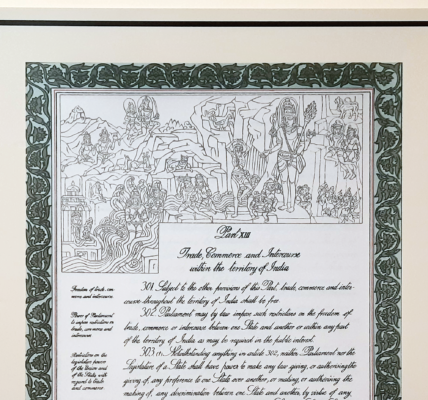FRAMING THE INDIGENOUS:
DISCOURSES OF FEMINIZATION OF AESTHETICS THROUGH THE ORNAMENTAL AND THE DECORATIVE IN ALPONA IN EARLY 20THC.BENGAL
DR. APARNA ROY BALIGA
Early twentieth century Bengal saw the redesigning of the cultural sphere during the upsurge of the Swadeshi movement. ‘The two central themes in this context are the familial social space designated as andarmahal / antahpur (inner-quarter) and griha (home/ household);the main creator-organizer of this space is named in the latter half of the century as grihini(the mistress of the home or the homemaker),especially in her incarnation of the bhadramahila as the mother. There is a shift in focus from the andarmahal to the idea of griha. Griha also had a wider connotation of being the embryonic nation and also the embodiment of the idea of the indigenous. Hencegriha, griha karma, and griha laxmi became the focus of the anticolonial discourse.
The Swadeshi aesthetics thus tried to formulate an alternate modernism which was based on the indigenous and appropriated the domain which primarily belonged to women. Abanindranath’s writings emphasize on the development of the indigenous. He mentions ’If one searches the sea one finds fish, salt, pearl but not diamond, one has to search the earth/soil where the artist was born and where he started creating.’ During this phase of nationalism or early phase of indigenous modernism one sees the reformulation of the question of aesthetics in the Indian terms, the revival of handicrafts and the redefinition of the concept of design and its relationship with painting. Counter ethnographic project of relooking, documenting and redesigning the new formulations of aesthetics took place. All his comparisons to describe art draws from the concept of the feminine or nature and sometimes both mingle and become a singular entity. The concept of femininity is adapted to define the ideal male. Art was also referred as kalalaxmi—-When Abanindranath talks about rupavidya he says—-‘From the very beginning people see rupavidya as the female companion [sahachari] of his leelas and till now looks similarly. “Grihini sachiva sakhimitha” just as it is for the beautiful lady similarly it is for the rupavidya.’ Abanindranath goes on drawing similitude with women, also adapts elements from striachar i.e. ritualistic practices like alpana, bratakatha or crafts like kantha .
Abanindranath created a counter ethnography or rather a search for the nationalist self. This led him to document the ‘Vratakathas’. He records the shastric or Brahminic vratas and also which are marginalized non- Brahminic in nature and belonged to all the classes and to another marginalized terrain that of the women. He discusses about the magic belief/ narration of desire and the aesthetic urge while writing about alpona (floor painting) in his book ’Banglar vrata’ almost in a similar language as Coomaraswamy’s when he talks about ornaments and its semantics. However Abanindranath takes it further to the formal realm beyond the metaphysical framework of Coomaraswamy .He gives the example of maghamandala vrata where different jewelries are painted as they are desired by the painter.
Alpana the art of floor painting became a vital part of the visualization of these cultural ceremonies. New symbols were created for the celebrations of specific events like Independence Day, Christmas or Brikshropan. Each had distinct character. Two significant practitioners of Alpona were Sukumari Devi and Gauri Devi.

